Text
What is In Virto Fertilization (IVF)?

In-Vitro fertilization or IVF is an assisted pregnancy technology procedure that assists couples with fertilization, embryo development, and implantation. During the procedure, they collect matured eggs from the uterus. They fertilize the egg with a sperm in the lab. The fertilized egg or eggs are transferred back into the uterus.
During the IVF procedure using your egg and your partner’s sperm or donor eggs and sperms are used.
Why is IVF done?
IVF is a procedure to help couples conceive. IVF can be expensive and invasive many couples try other fertility procedures before opting for IVF. IVF can treat the following conditions:-
Blocked or damaged fallopian tubes
Male factor infertility such as decreased sperm count or sperm mortality.
Ovulation disorders
Endometriosis
Women who have their tubes tied or removed.
Genetic disorder
Fertility preservation for cancer and other health conditions.
What happens before the procedure?
Before you start the IVF procedure, it is important to remember, the success of the procedure depends on many factors including your reproductive history, age, and the reason for infertility. Before you start treatment at a fertility clinic you and your partner are likely to undergo extensive tests such as-
Ovarian reserve testing:- The best gynecologist in Nasik will find out the quality and quantity of your eggs. Blood tests at home to determine the level of follicle stimulation hormone (FSH), estradiol, and anti-Mullerian hormone. Ultrasound can help your gynecologist determine if your ovaries will respond to treatment.
Semen analysis: The semen samples are analyzed during the initial evaluation procedure.
Infectious disease screening:- Both you and your partner are screened for infectious diseases including HIV.
Uterine exam – The uterine is examined by your doctor before you start IVF. The doctor uses a transvaginal ultrasound during the procedure.
What happens during the procedure?
Step 1 is the ovulation induction procedure. If your eggs are being used, the gynecologist near me will prescribe synthetic hormones to stimulate your ovaries to produce more eggs. They need multiple eggs since some eggs may not fertilize during the procedure. Your gynecologist will give you fertility medication at this stage. Blood tests at home and ultrasounds help the gynecologist near me track of your egg production.
Step 2 is the egg retrieval procedure. The gynecologist will retrieve your eggs during a minor surgical procedure. A transvaginal ultrasound helps guide them to retrieve the eggs with the help of a needle. The needle will remove the egg from each follicle. Medications help reduce potential pain and discomfort. You may experience cramping and a feeling of pressure or fullness after the procedure. The retrieved eggs are placed in a nutritive liquid and are incubated.
Step 3 is the sperm retrieval. The doctor’s clinic collects the semen sample. They separate the sperms from the fluid and prepare it to combine with the eggs.
Step 4 is the insemination process. The sperm and eggs are mixed and stored in a petri dish to promote fertilization. Intracytoplasmic sperm injection (ICSI) may encourage fertilization. The technicians examine the eggs to confirm fertilization. The fertilized eggs are called embryos.
Step 5 is the embryo transfer process. The gynecologist carries out the procedure at their clinic. It takes place after the retrieval and fertilization procedure. The embryo is transferred into your uterus with the help of a catheter.
Approximately 12 days after the procedure, the best gynecologist in Nasik will order blood tests at home to determine if the procedure was a success
0 notes
Text
World Sickle Cell Awareness day
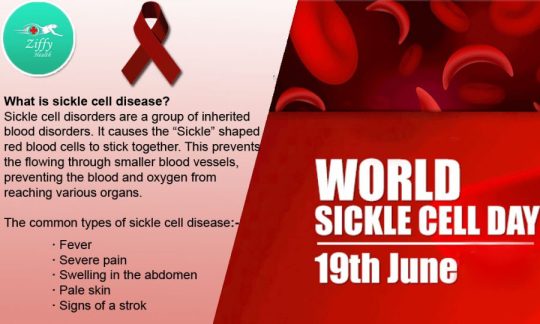
World Sickle cell awareness day has been held annually since 2008. The day hopes to raise and increase knowledge on Sickle cell disease or SCD and the struggles of the patients and their families go through. The resolution regarding Sickle cell disease was passed on 19th June 2008 by the General assembly in the UN. Every year on this day national and international programs around the world are held to raise awareness about the issue.
Every year organizations affiliated try to raise awareness about the disease and assisting patients and their families. Several screening programs are conducted in various parts of the world. The day highlights various surgical and medical options available to treat patients. New parents are educated about immunization and other health care options available. Organizations help to address myths and stigma associated with SCD. Due to the Covid-19 crises this year, many of the seminars are being conducted online.
What is sickle cell disease?
Sickle cell disorders are a group of inherited blood disorders. It causes the “Sickle” shaped red blood cells to stick together. This prevents the flowing through smaller blood vessels, preventing the blood and oxygen from reaching various organs. The life-span of these red blood cells is also reduced.
The common types of sickle cell disease are:-
HbSS or sickle cell anemia is the most severe form of the disorder. It occurs when the child inherits the sickle cell gene from each parent.
HbSC is when one parent has the sickle cell gene. HbSC is less severe.
HbS beta-thalassemia is when a person inherits the sickle cell gene from one parent and beta-thalassemia gene from the other.
Sickle cell diseases affect 5% of the world’s population. Hemoglobin disorders are caused by inherited mutant hemoglobin gene from both parents. Over 3 lakh babies are born with serious hemoglobin disorders every year. It is a common health problem in Asia and Africa. In India, sickle cell disease is more prevalent in North Maharashtra, South Gujarat, Madhya Pradesh, and western Odisha. According to ICMR, 20% of children with the disease do not survive beyond the age of two.
Symptoms of sickle cell disease are:-
Anemia
Episodes of pain
Frequent infections
Vision problems
Delayed growth or puberty
Increased risk of infection
Symptoms usually appear when the child is 2 to 4 months old. But can show up in their adolescence. Book doctor in Patna If you or your child who have been diagnosed with SCD show the following symptoms:-
Fever
Unexpected severe pain
Swelling in the abdomen
Pale skin or yellow tint in the skin
Signs of a stroke
The best doctors in Patna can diagnose SCD by ordering blood tests at home. If you or your partner has sickle cell disease the amniotic fluid (the fluid surrounding the baby) can be tested to determine if the unborn baby has the disease.
The best doctor in Patna treats sickle cell disease by pain management, relieving symptoms, and preventing complications. Treatment options include medication and blood transfusion. Some children and teenagers can opt for stem cell transplant as a possible cure.
In India, the Rashtriya Bal Swasthya Karyakram (RBSK) is a program that helps to identify children under the age of 18 with congenital defects, diseases, and development delays. Sickle cell anemia is covered under the scheme.
Repeated blood and blood components transfusions are provided free of cost. The government hopes to prevent the disorder by better screening and awareness strategies. In 2018 the government drafted a policy to provide affordable healthcare for hemoglobinopathies.
0 notes
Text
The Antibiotic resistance crises
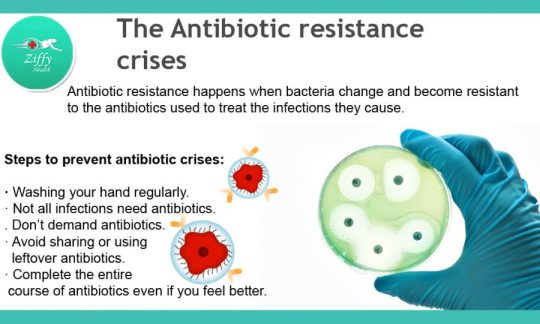
The United Nations has issued a warning that common diseases will become untreatable. The report cautioned nations that unless fundamental changes took place, the drug-resistance disease could kill over 10 million people by 2050.
Drug resistance occurs when we overuse antibiotics to treat animals or humans and plants. When a new antibiotic is introduced in the market it shows significant results are visible in the beginning. But bacteria adapt and the antibiotic becomes less effective. Doctors are unsure of how to treat the disease.
Antibiotic resistance has emerged to be one of the biggest threats. Anyone can sign of antibiotic resistance. Diseases such as pneumonia, tuberculosis, gonorrhea, and salmonellosis become harder to treat as the antibiotics prescribed to treat them become less effective. Antibiotic resistances lead to longer stays in the hospital, increased medical costs, and mortality.
The WHO released data collected from 114 countries, showed that the antibiotic resistance is much worse where there were fewer restrictions on antibiotics. Antibacterial resistance that emerges in one country can easily spread to another country. Inappropriate use of antibiotics for minor ailments such as a cold is the biggest reason for antibiotics. Food manufacturers inject poultry and livestock with antibiotics and improperly disposed of antibiotics has resulted in antibiotics entering our food chain. Researchers have found pharmaceutical contamination in the River Yamuna. Water samples in and around the Delhi NCR region shows a concentration of dissolved drugs.
Doctors are worried that the present Covid-19 crises could increase antibiotic resistance. Though COVID-19 is a virus, many people are taking antibiotics themselves to protect themselves. Many patients are being treated with antibiotics to prevent secondary infections. We have put all research on antibiotics on hold. There are fears that antibiotic research could fall years behind. Antibiotic researchers fear that different antibiotic resistance bacteria can further stretch the health care system already reeling under the Covid-19 crises. They are urging governments to increase spending on antibiotic research. Antibiotics could be as important as face masks and protective gowns. Previous scientific literature from the Spanish flu shows that 100 million deaths was because of bacterial infection affecting already weakened lungs.
Steps to prevent antibiotic crises:
Washing your hand regularly can help you to fight germs and prevent infections. Avoid close contact with sick people, practice safe sex, and keep up to date with all immunizations.
Be vigilant if you are showing symptoms of an infection. If you think you have an infection and are not improving, talk to the best doctor in Mumbai.
Don’t hesitate to ask the doctor near me questions about the antibiotics Ask them about side-effects. If admitted in a hospital or nursing home ask them how they keep their facilities safe and prevent further infection.
Not all infections need antibiotics. Don’t demand antibiotics.
Only take antibiotics when prescribed by the doctor near me. Complete the entire course of antibiotics even if you feel better.
Avoid sharing or using leftover antibiotics.
Foods such as meat, fruits, and vegetables can get contaminated with bacteria. Experts recommend four steps to prepare food safely at home. Eat hygienically prepared food, keep raw and cooked food separately, cook food thoroughly, and use clean water and raw material. Opt for food produced without antibiotics.
0 notes
Text
Dry Socket: A painful dental condition

Dry socket or (alveolar osteitis) is a painful dental condition that can occur after tooth extraction. A dry socket occurs when a blood clot does not develop at the site of the tooth extraction. It typically occurs 2 to 4 days after your tooth extraction.
Usually, a blood clot forms after your tooth extraction. The clot protects your nerves ending in the empty socket. It also serves as the base for the growth of the new bone.
The exposed nerve ending can be an extremely painful condition. The socket may become inflamed and can fill with food bits adding to the discomfort. It can become a serious complication if left untreated. Dry sockets last for 7 to 10 days.
Symptoms
The symptoms of dry socket are:-
Intense pain shortly after tooth extraction. The pain may radiate from the socket to the eye, teeth, and neck.
Tenderness
Partial or complete loss of blood clot at the site of the extraction. You may notice a dry socket.
Visible bone within the socket
Bad breath or unpleasant taste in the mouth.
Book a dentist in Pune if the pain worsens or cannot be helped with the prescribed pain killers.
Causes
The precise reason for dry socket is not known. Dentist suspect the following factors may increase the risk of dry sockets:-
A technically difficult tooth extraction.
Poor oral hygiene
Not following your dentist aftercare instructions after tooth extraction.
Using a straw or tobacco products after the procedure.
Aggressive rinsing and spitting can remove the clot.
Medication such as oral contraceptive and menstrual hormonal pills.
Diagnosis
The best dentist in Pune will suspect a dry socket if you complain of severe toothache after a dental procedure. They will examine the sight of the extraction to see if you have a blood clot or if the bone is visible within the socket.
The dentist may take an X-ray to ensure no fragment of your tooth was left behind during the previous procedure.
Treatment
The best dentist in Pune will try to reduce the symptoms especially pain. The treatment plan will be as follows:-
Irrigation of the socket of any food debris. This flushing will reduce the pain and flush out any infection.
They will put a medicated dressing in the socket to reduce pain. This dressing may need to be changed depending on your symptoms and the severity of the symptoms.
Prescribe pain medication for the dry socket.
Once the dressing is removed your dentist may ask you to continue flushing the socket at home. You may need to continue with this remedy till the socket is healed and food no longer collects at the site.
Prevention
Smoking and using tobacco products increase the risk of dry sockets. Avoid smoking for at least three days after your tooth has been extracted. Avoid drinking carbonated or warm drinks after the procedure. Don’t drink from a straw for at least a week after the procedure. The dentist may give you other post-operative care. You should not miss your follow up visit to ensure your wound is healing properly.
0 notes
Text
Handling your Allergies
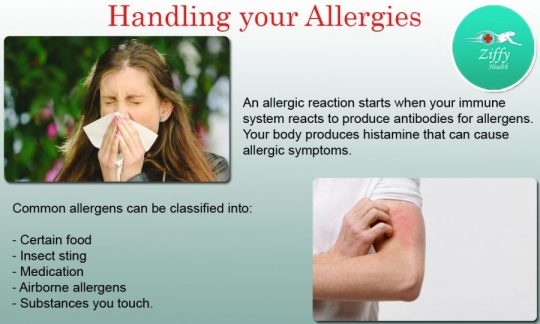
An allergic reaction occurs when your immune system is hypersensitive to foreign substances. The substance that causes allergies is called an allergen. Food, pollen, medication, and pollen venom are common allergens. Antibodies are produced by your immune system to protect us. When you are allergic to something your immune system mistakes the allergen as an invader. The symptoms of an allergic symptom can range from mild to severe. While allergies cannot be cured, treatment to relieve symptoms is available.
Symptoms
Allergic reactions usually trigger symptoms in the nose, lungs, throat, sinuses, ears, lining of stomach, or skin. An asthma attack can also be a symptom of an allergic reaction. In more serious cases allergies can have a life-threatening reaction called anaphylaxis to occur.
Allergic rhinitis (hay fever) is the most common allergic disease. It shows nasal symptoms due to aeroallergens (allergens in the air). Hay fever can be throughout the year or seasonal.
Common symptoms of hay fever are:-
Sneezing
Itching of nose, eyes or roof of the mouth
Runny and stuffy nose
Water, red or swollen eyes (conjunctivitis)
Symptoms for food allergies are:-
Tingling in the mouth
Swelling of the lips, tongue, face, or throat.
Hives
Anaphylaxis.
Insect allergies show the following symptoms are:-
Swelling or edema at the sting site
Itching and hives throughout the body
Cough, tightness in the chest, shortness of breath (wheezing)
Anaphylaxis.
Symptoms of drug allergy are:-
Hives
Itchy skin
Rash
Face swelling
Wheezing
Anaphylaxis
Atopic dermatitis or eczema is an allergic skin condition. Symptoms of eczema are:-
Itching
Redding of skin
Flake or peel
Anaphylaxis is a life-threatening emergency. Signs and symptoms of are:-
Loss of consciousness
Drop-in blood pressure
Severe shortness in breath
Skin rash
Lightheaded
Rapid and weak pulse
Nausea and vomiting
Book a physician in Patna if you think you have symptoms caused by an allergic reaction. Anaphylaxis needs immediate medical attention.
Causes
An allergic reaction starts when your immune system reacts to produce antibodies for allergens. Your body produces histamine that can cause allergic symptoms. Allergies can develop at any age but most allergies begin in childhood. Environmental allergies can develop at any time. Allergies can be genetic or in your family history. Children born via Caesarean section are at a higher risk of developing allergies.
Common allergens can be classified into:-
Airborne allergens – pollen, animal dander, dust mites, etc
Certain food – peanut, shellfish, soy, eggs, milk, etc
Insect sting- bee or wasp
Medication – penicillin or penicillin-based antibiotics
Latex or substances you touch.
Diagnosis
The best physician in Patna will perform a detailed physical examination. It will be helpful if you have listed your symptoms with possible triggers. The best doctor in Patna may recommend the following tests:-
Skin test – During the test the doctor or nurse will prick your skin with a small amount of the potential allergen. If your skin develops hives you may be allergic.
Blood tests at home – Specific IgE (sIgE) blood test is commonly used to diagnose allergic reactions.
Treatment
The best physician in Patna will help you identify the allergy triggers. You can avoid the triggers. Avoiding the triggers will help you prevent symptoms associated with allergies. They may prescribe medication to ease symptoms. For very severe symptoms the physician near me may recommend immunotherapy. If you have very severe reactions you may need to carry an EpiPen to reduce symptoms until you can get emergency treatment.
0 notes
Text
What Is Astigmatism?

Astigmatism is a common eye problem. The problem is caused by imperfections in the curvature of your eyes causing blurred distance or near vision. Normally your corneas and eye lens are smooth and uniformly curved in all directions. Astigmatism is a refractive error caused by the irregular shape of your cornea.
Astigmatism is a common eye problem that can usually occur with myopia (nearsightedness) or hyperopia (farsightedness). We can diagnose the problem with a simple eye exam.
Astigmatism is a refractive error and is not an eye disease. Your eye has a problem focusing light.
Astigmatism can be because of a congenital defect or can occur when you are older. Some people have a combination of myopia and hyperopia.
Symptoms
Symptoms of astigmatism are:-
Blurry vision or distorted vision.
Eye strain or discomfort.
Squinting your eyes to see clearly.
Headache
Difficulty seeing at night.
Book an ophthalmologist in Mumbai if you have any of these symptoms or your vision prevents you from enjoying or interfere with everyday tasks. Children may not realize they have eye problems you should get your child’s vision tested periodically.
Causes
Astigmatism is caused by asymmetrically shaped corneas. Our eye has two curved surfaces (cornea and lens) that refract light onto your retina. When the cornea and lens are perfectly shaped you get a focused image on your retinas.
Refractive error is caused when either your lens or cornea has mismatched curves. The imperfect refractive images cause blurred images. The blurred vision may be horizontal direction, vertical or diagonal direction.
Astigmatism can be a congenital defect or may develop after an injury or surgery. The condition is not caused or made worse by reading in poor light, sitting too close to the television or squinting.
There are three types of Astigmatism are:-
Myopic astigmatism is when your cornea has curved too much or your eye is longer than normal. The condition makes distant objects look blurry.
Hyperopia occurs when your cornea has curved too little or your eye is shorter than normal. The condition makes the near object look blurry.
Mixed astigmatism occurs when your corneas are irregularly shaped. One eye may have myopia and the other hyperopia.
Diagnosis
The best ophthalmologist in Mumbai will diagnose astigmatism during an eye examination. During the examination, they will check the health of your eyes. They may use the following tests:-
Visual acuity assessment test – you will have to read letters and numbers from a chart.
The Refractive test uses a machine called optical refractor where the ophthalmologist near me tries to find the lens while you read the letter and number chart.
Keratometry helps the ophthalmologist determine the curvature of your cornea.
Treatment
The best ophthalmologist in Mumbai treats mild-to-moderate astigmatism by prescribes eyeglasses or contact lenses. The glasses or contact lenses help to compensate for the uneven curvature of your cornea or lens.
Orthokeratology (ortho-K) a procedure where you wear rigid contact lenses at night to even out the curvature of your eyes. You were the lenses less frequently to maintain the newly corrected shape.
The ophthalmologist near me may suggest a refractive surgery. Small knives or laser is used to reshape the curves of your cornea. Since it is laser surgery, there are some risks associated with the procedures. Discuss the pros and cons with your doctor.
It is important to treat astigmatism as soon as possible. Once diagnosed, you need to visit your ophthalmologist to make sure prescription has not changed.
0 notes
Text
Pregnancy during the COVID-19 crisis
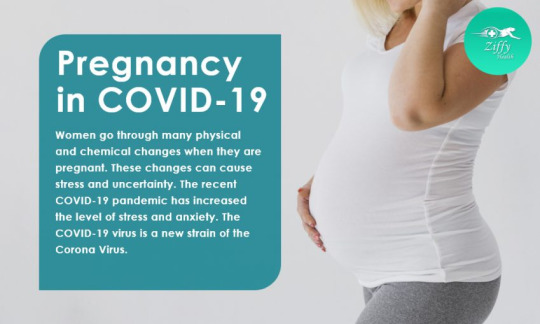
Women go through many physical and chemical changes when they are pregnant. These changes can cause stress and uncertainty. The recent COVID-19 pandemic has increased the level of stress and anxiety. The COVID-19 virus is a new strain of the Corona Virus. Researchers are scrambling to learn more about the virus and the effect of the virus can have on pregnant women.
Pregnant women are feeling vulnerable to lockdown in place. The good news is that there have been no indications that pregnant women are more vulnerable. Researchers remember that the SARS virus outbreak in 2003 had a higher fatality for pregnant women (about 25%).
Doctors expect most pregnant women will experience mild-to-moderate symptoms if the virus infects them. Elderly and those we weakened immune systems or people with chronic health conditions seem more vulnerable.
The prenatal visit has become difficult during the present lockdown. These visits are essential to ensure maternal and fetal health. Ask your gynecologist if you can monitor your blood pressure at home and monitor your baby’s movement. You can opt to consult your gynecologist via video consultation if you feel there is something wrong.
If you feel you have symptoms of COVID-19 contact your doctor immediately. The doctor may recommend COVID-19 blood tests if you are showing symptoms. India has both governmental and private testing.
Many women are worried if their baby will be affected if they get infected. There are no indications that the virus can cause miscarriage or early pregnancy loss. Some infected mothers in China delivered their babies prematurely, but it is unclear if the virus caused premature labor or if the decision to deliver early was based on concerns of the mother’s health.
There is evidence that transmission from a pregnant mother to her baby is likely. 33 babies in Wuhan, China during the COVID-19 experience 9% (3 babies) tested positive at birth. The babies were fortunate to experience mild symptoms, including fever and pneumonia. Fortunately, all babies recovered within a week.
The hospital will place the baby in isolation if the mother is infected with COVID-19. Doctors will wear protective garb before treating and assessing your baby, Right now there is no evidence that COVID-19 can be passed through breast milk. Infected mothers can also use a breast pump following proper pumping hygiene.
To prevent the chances of infection pregnant women should practice all the safety norms prescribed by doctors such as washing your hands and practice social distancing. Avoid going to public places. You can ask the hospital about the current protocol, about the current rules on visitors.
Visit us - https://www.ziffytech.com/
0 notes
Text
World Health Day 7th April 2020
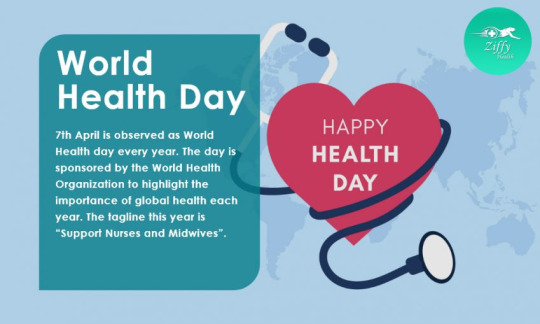
7th April is observed as World Health day every year. The day is sponsored by the World Health Organization to highlight the importance of global health each year. The World Health Organization was founded on 7th April 1948 the day is commemorated as World Health Day every year. World Health Day took effect in 1950 each year the day is celebrated with a particular theme. The theme of World Health Day2020 is celebrated as the “Year of Nurses and mid-wives” to commemorate the 200th birth anniversary of Florence Nightingale. The tagline this year is “Support Nurses and Midwives”. While last year the focus was on universal health coverage.
This year the world health day plans to focus on the critical role played by nurses and midwives patient care and asked for strengthening the nursing and midwife workforce throughout the world.
The WHO honors the role of nurses and other healthcare professional play in patient care and welfare. This year the theme becomes more apt with the present COVID-19 crises. According to the WHO, a robust workforce of nurses and midwives will ensure that everybody will get the healthcare they need. It will allow countries to realize their national and global target connected to universal health care, maternal and child health, infectious and non-infectious diseases, and mental health. It includes a country emergency alertness and response, patient-centric care, etc.
Nursing and midwives play a vital role in the healthcare industry to ensure the world is healthier.
This year the COVID-19 pandemic has affected people all over the world. Nurses have played a critical role in providing quality care and treatment, attending to their patient’s needs and providing comfort. They have also been instrumental in collecting data for clinical studies and research to tackle the pandemic.
The WHO also released “State of the World’s nursing report 2020” to provide the latest evidence on and policy options for the global nursing workforce. The report highlighted the need for higher investment in nursing education, jobs, and management.
According to the report, 70% of global health and social workforce is made up of women, nurses and midwives make a significant portion of this workforce. Leaders all over the world and in India took to Twitter to greet their followers.
Here are some healthy practices you can adopt on World Health day to improve your health.
Eating a healthy and balanced diet can prevent many diseases. You should incorporate plenty of nutrients into your daily diet. Your meals should contain proteins, vitamins, and carbohydrates. Make informed decisions when you buy processed or semi-processed food and read ingredients used in the product.
Obesity is linked to numerous health problems such as diabetes and hypertension. A healthy weight can reduce the risk of several diseases. It is important to incorporate exercise as a part of your daily routine.
We must pay attention to our mental health. Our mental health can affect our daily activities and general health. Meditating or breathing exercises can help boost our mental health. If you are experiencing symptoms such as prolonged depression or anxiety it is important to seek help immediately.
Avoid smoking and excessive drinking. Many health problems are caused due to smoking and excessive drinking.
It is important to remain hydrated. Drinking water, herbal teas, or lemon water are healthier than drinking cola, caffeine, or carbonated drinks to avoid excessive consumption of sugar.
Visit Us: www.ziffytech.com
0 notes
Text
Treating and Diagnosing Meniscus Tear

Meniscus tear is a common knee injury. Athletes involved in contact sports are at a higher risk of a meniscus tear. The knee joint is the largest joint in your body. Your knee joint is composed of the thighbone (femur), shinbone (tibia), and kneecap (patella). Two wedge-shaped cartridges between your thighbone and shinbone are called meniscus. The meniscus acts as shock absorbers and help cushion and stabilize your joint. Torn meniscus causes pain, swelling, and stiffness in your knees. Your range of knee movement may be difficult.
A meniscus tear can occur in different ways. We can classify tears by how the appearance and location. Common types of meniscus tears are:-
· Bucket handle tear
· Flap tear
· Radial tear
· Parrot break
Symptoms
· Symptoms of a meniscus tear are:-
· Pain in your knee joint.
· Swelling and stiffness.
· Difficulty in mobility or straightening your knee fully.
· Feeling your knee is locked in place.
· Limping.
· Popping sensation.
· Giving way or buckling of your knee.
An untreated torn meniscus can lead to your knees giving in, inability to move your knees and persistent knee pain. Book an orthopedic doctor in Patna if your knee is swollen or sore or if it is locked in place.
Causes
Meniscus tear is caused when you forcefully twist or rotate your knee. The injury often happens during contact sports. Kneeling, squatting or lifting heavy objects can cause a meniscus tear. Elderly people can have a degenerative meniscus tear. Your cartridges can weaken and wear down as you age. Aged and worn tissues are more likely to tears.
Diagnosis
The best orthopedic doctor in Patna will test your medical history and physical examination of your knee. They will feel, assess the tenderness and stability of your joint. They will test the range of motion of the knee. During the physical doctor, they may predict if your medial or lateral meniscus is damaged. But imaging tests are required to confirm the diagnosis.
The orthopedic doctor near me may order imaging tests such as an X-ray or an MRI. They may use an arthroscope to examine the inside of your knees.
Treatment
The best orthopedic doctor in Patna makes your treatment plans depending on the size and location of the tear, your age, and your overall health and medical history. For a minor injury, they may prescribe over-the-counter medication to reduce inflammation and pain. They may recommend RICE (Rest, ice, compression, and elevation) treatment on the injured knee. They may suggest you visit a physiotherapist in Patna to strengthen your knee and legs and stabilize and reinforce your knee joint.
The orthopedic doctor near me may recommend surgery if the joint remains painful after therapy. During the surgery, your meniscus may be trimmed or repaired using the arthroscope. After the surgery, you will need to exercise gradually to increase and maintain knee strength and mobility. They may recommend knee replacement surgery if you have degenerative arthritis.
Meniscus tear is a common injury with accurate diagnosis and treatment most people return to their pre-injury activity.
0 notes
Text
Symptoms and diagnosis of peptic ulcers
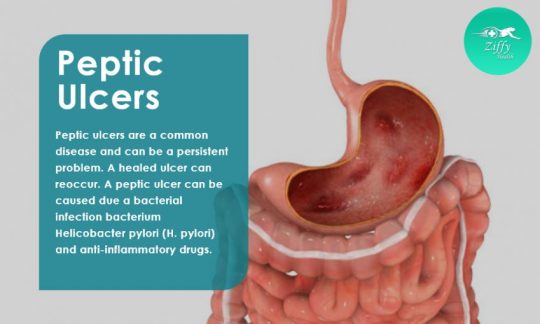
Peptic ulcers are open sores that develop inside the lining of the stomach and upper part of your small intestine (called the duodenum). Your stomach is protected by a thick layer of mucus to protect it from digestive juices. WE get ulcers when the protective layer is reduced.
There are two types of peptic ulcer:-
Gastric ulcers occur in your stomach.
Duodenal ulcers occur in the upper part of your small intestine.
Peptic ulcers are a common disease and can be a persistent problem. A healed ulcer can reoccur. A peptic ulcer can be caused due a bacterial infection bacterium Helicobacter pylori (H. pylori) and anti-inflammatory drugs. Stress and spicy food do not cause ulcers, though they can aggravate the symptoms.
Symptoms
Symptoms of peptic ulcers can vary, you may or may not have symptoms. Common symptoms of ulcer are:-
Burning pain in the stomach.
Feeling full, bloated or belching.
Intolerance for fatty food.
Heartburn.
Nausea
Your symptoms can worsen with an empty stomach. The pain may stop briefly when you have an anti-acid or after eating.
More severe symptoms of peptic ulcer include:-
Vomiting or vomit that appears red.
Dark, bloody stool or black stool.
Breathing problem.
Appetite changes.
Unexplained weight loss.
Book a gastroenterologist in Patna if you have any severe symptoms. You should also see the doctor if the over-the-counter anti-acids stop the pain temporarily.
Causes
Peptic ulcers are caused by an imbalance between the digestive fluid in your stomach (hydrochloric acid) and pepsin in your stomach and duodenum due to:-
Infection with a bacterium called Helicobacter pylori (H. pylori). Researchers are not sure how the bacteria spread. We can transmit it from person to personn personal contact or from food and water.
Using nonsteroidal anti-inflammatory drugs (NSAID) such as Aspirin, ibuprofen, Naproxen, and celecoxib. These medicines can irritate the lining of your stomach and duodenum. Peptic ulcers are more common with the elderly who take pain medication or medication for osteoarthritis.
A condition called Zollinger-Ellison syndrome causes excessive production of stomach acid. Gastrinoma a tumor of the acid-producing cells increases the production of acid. Smoking, drinking alcohol, untreated stress, and eating spicy food make your ulcers more difficult to treat.
Diagnosis
The best gastroenterologist in Patna will start by looking at your medical history and performing a comprehensive medical examination. They may order the following tests:-
Upper endoscopy:- the gastroenterologist uses a tube equipped with a camera to probe your upper digestive tract.
A barium upper gastrointestinal GI X-ray is used to make the ulcer visible.
Laboratory tests to determine H. pylori bacteria through stool tests or blood tests at home, or breath tests. Doctors consider the breath test to be more accurate than blood tests. If you have the bacteria, your breath sample will contain radioactive carbon in the form of carbon dioxide.
Treatment
The best gastroenterologist in Patna will treat your peptic ulcers by suggesting lifestyle changes, prescribing medication or surgically.
They may prescribe:-
Antibiotics to kill H.pylori.
Proton pump inhibitors (PPI) reduces stomach acid by blocking the cells that produce acid. There are some side-effects of the medication.
Acid blockers to reduce acid production.
Anti-acids.
Medication to protect your stomach lining and intestine.
The gastroenterologist near me may perform a simple endoscopy procedure. They may opt to treat the ulcer surgically if there is a hole in the stomach or serious bleeding.
0 notes
Text
Tackling Chickenpox
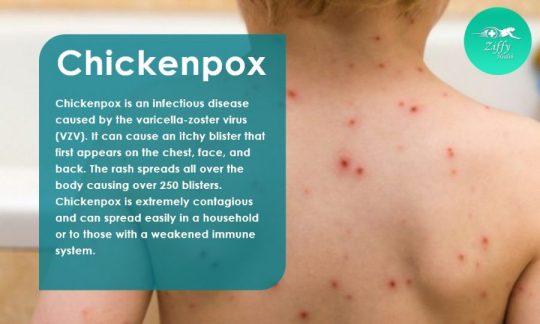
Chickenpox is an infectious disease caused by the varicella-zoster virus (VZV). It can cause an itchy blister that first appears on the chest, face, and back. The rash spreads all over the body causing over 250 blisters. Chickenpox is extremely contagious and can spread easily in a household or to those with a weakened immune system. You are vulnerable if you have not had chickenpox or have not been vaccinated. Chickenpox usually affects children below 10 years but can affect adults as well. The viral infection usually lasts for 10 days.
Symptoms
The first symptoms can appear 10 to 21 days after being exposed. Typical signs of chickenpox are:-
Blister itchy rashes that begin in the face, and the trunk before spreading. In severe cases, the blisters can spread inside the eyelid, mouth, throat, and genital area as ulcers.
Fever
Headache
Lack of appetite
Fatigue and drowsy feeling.
The rash goes through three phases and starts as raised pink or red bumps (papules) appearing all over the body. These bumps become blisters (vesicles) full of fluid that break and leak. The bumps eventually become crusts and scabs and begin to heal. You are contagious from 48 hours before the rash appears till all crusty areas have fallen over. Chickenpox is usually mild in children. Book a pediatrician in Nasik if you think your child has chickenpox. If you are an adult with the symptoms contact a physician near me.
Causes
Chickenpox is a contagious viral infection. It is caused by the varicella-zoster virus (VZV). It can spread when an infected person coughs or sneezes or come in direct contact with the blisters. The infection can also spread through salvia.
Chickenpox can be very severe for people suffering from bacterial infection, dehydration, pneumonia, or Reye infection. People with weak immunity and children with asthma are more vulnerable. Pregnant women who have never contacted chickenpox can risk infecting the fetus called congenital varicella syndrome.
Diagnosis
The best pediatrician in Nasik will diagnose chickenpox based on the rash. They may order blood tests at home or take culture samples of the blister to confirm the diagnosis
Treatment
The best pediatrician in Nasik may prescribe an antihistamine to provide relief against the itching. Most children recover without any complications. In case your child is infected they should not attend school or daycare to prevent the spread. If you are at a higher risk of infection they may prescribe medication to help you recover faster and reduce the severity of the infection.
Patients should avoid scratching to prevent scarring. Scratching can prevent scabs from getting infected. The pediatrician near me may prescribe home remedies or medication to relieve symptoms associated with chickenpox.
Prevention
The chickenpox vaccine can prevent the infection in 90% of children who receive the vaccine. The vaccine is usually administered between 12 to 15 months. A booster shot is given when your child is between 4 to 6 years of age. Older children can receive two catch-up doses to be vaccinated four weeks apart. Adults who can receive the two doses of the vaccine four to eight weeks apart. Your physician near me will be able to give you more details.
0 notes
Text
Diagnosing and Treating Cellulitis
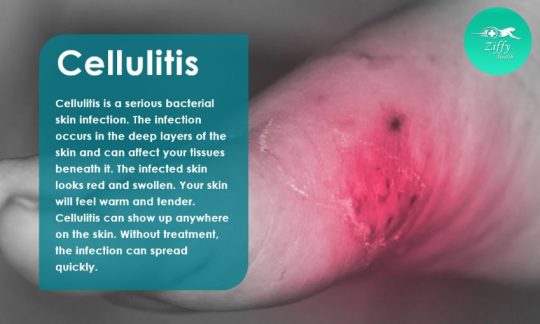
Cellulitis is a serious bacterial skin infection. The infection occurs in the deep layers of the skin and can affect your tissues beneath it. The infected skin looks red and swollen. Your skin will feel warm and tender. Cellulitis can show up anywhere on the skin. Adults usually get it on their lower leg while children get the bacterial infection on their faces and neck. Cellulitis occurs when there are cracks or break in your skin allowing the bacteria to enter.
Without treatment, the infection can spread quickly. The infection can travel to your lymph nodes through the bloodstream and become life-threatening. Cellulitis is a no communicable infection and does not spread from one person to another. Cellulitis around the eye socket is called periorbital cellulitis. This is an extremely serious infection and can spread to the brain if left untreated.
Symptoms
Symptoms of cellulitis can vary from person to person. Common symptoms of the infection are:-
Redness of the skin
Swelling
Tenderness
Warm skin
Pain
Bruising
Blisters
Fever
Skin dimpling
Book a dermatologist in Mumbai if you feel you have cellulitis. Cellulitis needs to be diagnosed and treated before the infection becomes more acute. Some cases of cellulitis can be an emergency.
Contact your doctor if you have the following symptoms:-
A large area of red and inflamed skin.
The affected area is numb or tingling.
The skin appears black.
The area around the eyes or behind the ears.
You are diabetic or have a weak immune system.
Causes
Cellulitis is a result of a bacterial infection. Most cases of cellulitis are caused by Streptococcus pyogenes (strep) or Staphylococcus aureus (staph). A strain of staph called community-acquired methicillin-resistant staphylococcal aureus, or “community-acquired MRSA” can lead to blistering of the skin and a deeper, more serious infection.
The bacteria enter your body when you injure your skin. Cuts, open sores, severe burns, surgery, ulcers or excessively dry skin can cause cracks or breaks on your skin. Other bacteria can cause cellulitis, after an animal bite, puncture wound or exposed wound. It can develop from fungal infection such as athlete’s foot.
Diagnosis
The best dermatologist in Mumbai will diagnose cellulitis after reviewing your medical history and conduct a physical examination. They may recommend blood tests at home to rule out other causes. They may take blood tests and skin samples to detect the type of bacteria.
The dermatologist near me may order imaging tests such as X-rays to determine if the infection has spread to the bone.
Treatment
The best dermatologist in Mumbai will make a treatment plan depending on your age, general health, and the severity of the infection. Getting your cellulitis treated immediately can prevent the spread of the infection. Treatment options include :
Topical, oral, or intramuscular or IV antibiotics
Pain medication
Cool, wet dressing on the infected area.
Keeping the infected area clean and dry.
If you have cellulitis in your leg, elevating the affected leg may reduce inflammation and help you heal faster.
Rest and giving time for the infection to heal may help faster.
The dermatologist near me may opt for surgery if conventional medication is not working or the infection has spread.
The infection will clear up with treatment, but there are chances of cellulitis reoccurring.
0 notes
Text
What is Torticollosis?
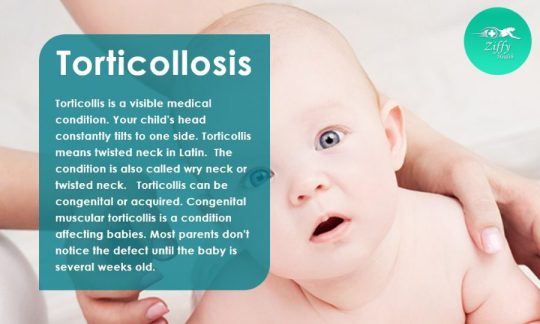
Torticollis is a visible medical condition. Your child’s head constantly tilts to one side. Torticollis means twisted neck in Latin. The condition is also called wry neck or twisted neck. Torticollis can be congenital or acquired. Congenital muscular torticollis is a condition affecting babies. Most parents don’t notice the defect until the baby is several weeks old. Toricollosis is a rare medical condition in India.
Congenital muscular torticollis responds to physical therapy, especially if you start the treatment early.
Acquired torticollis usually starts when the child is 4 to 6 months old or later. The symptoms may start suddenly or come gradually. Acquired torticollis is usually not associated with facial asymmetry. Acquired torticollis can be the sign of a more serious health problem.
The different types of torticollis are:-
Laterocollosis is when the head is tipped towards the shoulder.
Rotational torticollis when the baby’s head rotates along the longitudinal axis.
Anterocollis is when the head and neck bent in the forward direction.
Retrocollis is when the head and neck are bent backward.
Symptoms
The symptoms of torticollis differ depending on the type of torticollis. Common symptoms of torticollis are:-
Your baby’s head tilts to one side and chin points in the direction of the opposite shoulder. 75% of babies with the condition, the muscles on the right side of the baby’s neck is damaged.
A limited range of motion of your baby’s neck makes it difficult for the baby to turn its head from side to side or up and down.
In the first few weeks of your baby’s life, a soft lump is felt in the affected neck muscles. The lump is painless and usually goes away before your baby turns 6 months.
One side of your baby’s face and head may flatten since the baby always sleeps on one side.
Other symptoms may include:-
Neck pain
Thickened or tight sternocleidomastoid muscle
Tender cervical spine
Tremor in head
Unequal shoulder height.
If you notice your baby head is tilted to one side book pediatrician in Nasik.
Causes
The cause of torticollis defers on the type of torticollis.
Congenital muscular torticollis is caused when the sternocleidomastoid muscle (SCM) has become shortened or contracted. The SCM muscle on either side of the neck and controls the movement of your head. Your SCM can contract and cause your child’s head to tilt on one side:-
The position of your baby in the womb before birth.
Abnormal development of SCM muscle
Trauma or damage to the muscle during birth.
Acquired torticollis can be caused due to:-
Mild viral infection
Minor trauma to head and neck
Gastroesophageal reflux
Abnormalities in the cervical spine
Vision problems
A reaction to a medication.
Diagnosis
The best pediatrician in Nasik will examine your child. They will ask you questions about their development and growth. They may order imaging tests such as z-rays and MRI to determine if there are any skeletal abnormalities. During the physical examination, the pediatrician near me will
Check out the range of motion
Lightly look for pseudotumors
Look and feel for asymmetrical and unevenness of the face and neck
Check the rotation of your baby’s hip.
Treatment
The best pediatrician in Nasik will try to treat torticollis medically before trying the surgical options.
Non-surgical options are exercising the SCM muscles. Your pediatrician may recommend a physiotherapist in Nasik who will teach you the correct exercises. About 10% of torticollis cases are treated surgically usually when your child reaches preschool.
0 notes
Text
Different treatment methods for Bursitis
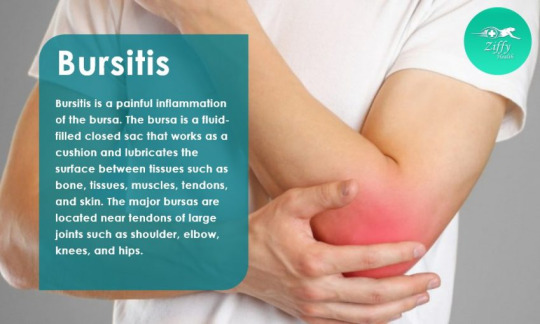
Bursitis is a painful inflammation of the bursa. The bursa is a fluid-filled closed sac that works as a cushion and lubricates the surface between tissues such as bone, tissues, muscles, tendons, and skin. The major bursas are located near tendons of large joints such as shoulder, elbow, knees, and hips.
Bursitis is usually a temporary condition. It may limit your mobility but does not cause the deformity of the joint. The pain may come gradually or sudden severe burst of pain.
The common types of bursitis are:-
Retromalleolar tendon bursitis (Albert disease) causes pain in the bursa in front of the Achilles tendon and the heel. The inflammation can be because of an injury or disease.
Posterior Achilles tendon bursitis or Haglund deformity. It causes pain in the bursa between the skin of your heel and the Achilles tendon. Walking in hardback support shoes can aggravate bursitis.
Hip bursitis or trochanteric bursitis can be caused by an injury, fatigue, spinal deformities, arthritis or surgery. Hip bursitis usually affects middle-aged or older women.
Elbow bursitis is caused when the bursa between your skin and elbow is inflamed. It can due to an injury or continuous pressure on the elbow.
Knee bursitis or goosefoot bursitis or Pes Anserine bursitis. The bursa can be found between the shinbone and the hamstring muscle tendon. This can be caused by skipping warm-up exercises before a workout.
Kneecap bursitis (Prepatellar bursitis) is a common injury in people who work on their knees.
Symptoms
If you have bursitis, the joint affected may show the following symptoms:-
Be painful and stiff.
Hurt more when pressed or when you move.
It looks swollen and red. It is warm when touched.
Book an orthopedic doctor in Patna if the condition if you have-
Extreme pain in the joint.
Unable to move the joint
The affected joint is swollen, red and bruised or
Sharp pain after the exertion of the joint.
Fever.
Causes
Bursitis is caused by repetitive movement or repeated minor impact of the affected area. It can also be caused by an injury or trauma to the affected area or other medical conditions such as arthritis and gout. Bursitis increases with age.
Diagnosis
The best orthopedic doctor in Patna will start with a thorough examination of your medical history and physical examination of the affected bursitis. They may order the following medical tests:-
Imaging tests such as X-ray or ultrasound, MRI. Though X-ray cannot confirm bursitis. They can exclude other medical conditions. The other imaging tests may be ordered if the doctor is unable to locate bursitis.
Blood tests at home to rule out other conditions.
Sample of fluid from the inflamed joint.
Treatment
The best orthopedic doctor in Patna tries to reduce the pain and inflammation and preserve the mobility of the joint. They may prescribe anti-inflammatory drugs. Inject corticosteroid injections can relieve intense pains. They may opt to surgically drain bursitis. Use RICE (Rest, ice, compression, and elevation) may help reduce the symptoms.
The orthopedic near me may recommend a physiotherapist in Patna to teach you exercises or show you how to ease pressure in the affected area. The orthopedic doctor may recommend some support such as a walking stick to ease pressure on the affected joint.
Ayurvedic doctor in Patna may treat bursitis may prescribe oral medication to help manage the pain. The doctor may ask you to apply special herbal oils. They may suggest some yoga asanas to help reduce pain.
0 notes
Text
What is Endometriosis
Endometriosis is a common gynecological condition affects 25 million Indian women. The name is derived from endometrium which are tissues lining the uterus. During your menstrual cycle, the endometrium grows inside your uterus and is shed when you don’t get pregnant. Endometriosis involves the tissues grows outside your uterus and other reproductive organs, tissues lining the pelvis or the abdominal cavity.
Women with endometriosis, the endometrium tissues do not exit the body after your menstrual cycle but get trapped in your uterus. When endometrium involves the ovaries, a cyst called endometriomas may form. Endometriosis causes the surrounding tissues to become irritated and form scar tissues and adhesion. The fibrous endometrium tissue can stick with each other.
Endometriosis can cause severe pain, especially during menstruation. It can also cause fertility problems.
Endometriosis is found on:-
Ovaries
Fallopian tubes
Tissues holding the uterus in place
The outer surface of the ovaries.
It can be found in other reproductive organs such as vagina, cervix, and vulva. In some cases it bowel, bladder, and rectum. In rare cases, endometriosis can be found in other parts of the body such as lungs, brains, and skin.
Symptoms
Women experience different symptoms of endometriosis. Common symptoms of endometriosis are:-
Painful period and excessive menstrual cramps in the lower back and abdomen.
Pain during intercourse.
Unusually and heavy menstrual bleeding. Several women experience bleeding between periods.
Infertility
Painful urination and bowel movement during menstruation.
Other symptoms may include fatigue, diarrhea, constipation, bloating, or nausea, especially during periods.
Book a gynecologist in Mumbai if you are experiencing signs and symptoms of endometriosis.
Causes
Researchers are unsure about what causes endometriosis. According to researchers, endometriosis may be caused by:-
Retrograde menstrual flow caused when some tissue that sheds after menstruation enters the fallopian tubes into other areas of the body such as your pelvic region.
Endometriosis may be genetic. The condition can run in some families.
Problems in your immune system and some cancers.
Hormonal problems.
During surgeries such as Cesarean or hysterectomy, the endometrial tissues could be moved by mistake.
Diagnosis
The best gynecologist in Mumbai will evaluate your medical history and complete a physical examination that will include a pelvic examination. They may perform a laparoscopy procedure to collect biopsy samples. Laparoscopy is a minor surgical where a thin tube with a camera is inserted into your abdomen via a small incision.
Other tests ordered by them may include imaging tests such as ultrasound and MRI scans.
Treatment
The best gynecologist in Mumbai treats endometriosis either medically or surgically. They prefer to treat the condition medically before opting for surgical treatment. Treatment options include:-
Pain medication prescribed may be over-the-counter pain medication or nonsteroidal anti-inflammatory drugs.
Supplementary hormonal therapy can help with the pain and slow down endometrial tissue growth.
Endometrioses can cause fertility problems. The gynecologist near me may suggest fertility treatment.
The gynecologist near me may opt for laparotomy to remove the displaced endometrium. They may suggest a hysterectomy to remove the uterus and in some cases ovaries.
0 notes
Text
What should Diabetics know about COVID-19?
COVID-19 is a highly infectious viral infection due to the Novel Coronavirus. The infection originated in Wuhan, China where it spread quickly. There are over 2,258,516 n people infected with the virus around the world and over 154,371 deaths. In India, there are 14,378 confirmed cases and 201 deaths. The virus is a new strain and countries around the world are unsure how to tackle and treat the virus.
The virus spreads via the droplets when an infected person coughs, sneezes, or talks. The virus can survive in the air and on solid surfaces for a few hours or days depending on the type of surface. If you touch a contaminated surface and then touch your nose, mouth, or eyes you can get infected. The virus is killed in the environment when the surface is wiped with an alcohol-based solution.
Most people experience mild to moderate symptoms and make a complete recovery. Symptoms of COVID-19 are:-
Muscle pain and headache
Fever
Dry Cough
Fatigue
Sore throat
Repeated shaking with chills
Loss of smell and taste
More severe symptoms may include:-
Pneumonia
Breathing difficulty
Diarrhea
Chest pain
Death
The World Health Organization has said patients with Type 1 or Type 2 diabetes are at a higher risk of serious infection if they contract the virus. People with diabetes have lower immunity levels. Your immune system protects you from infections. Diabetic patients may have other health problems such as high blood pressure, obesity, and heart disease. This will make you more susceptible to infections. Research showed that 22% of patients hospitalized in China with severe infections had diabetes.
Other than diabetes other high-risk categories are:-
cancer patients
Smokers
Bone marrow transplant or organ transplant patients.
Patients taking immune-suppression medications or steroids.
If you have AIDS or HIV.
Patients with chronic lung disease or you suffer from moderate or severe asthma.
Patients with chronic lung or kidney infections.
If you are over 65.
Your risks are higher if you don’t control your sugar levels. Higher sugar levels lower your immunity levels. Lower immunity levels make fighting the infection tougher. It is important to manage your diabetes more vigilantly in this period. Eat healthy meals, exercise indoors for at least 30 minutes. Exercise will improve your mental health as well. It is extremely important to have your medication on time. It is important to ensure you have insulin or glucose tablets handy. You can order your medicines at home in advance before your supply ends. You can monitor your sugar levels with blood tests at home or using a glucometer. Type 1 diabetic patients can either order urine tests or use urine ketone strips. If you feel your diabetic symptoms are worsening you can consult your doctor through video consultation.
It is extremely important to follow the precautions laid down by the government such as:-
Clean your hands with either soap or sanitizer frequently for at least 20 seconds.
Wear a mask when you are feeling unwell.
Sneeze or cough into tissues that must be disposed of properly.
Practice social distancing.
Clean and disinfect surfaces at home frequently.
Stay indoors as much as possible.
0 notes
Text
World Liver Day
The World liver day is observed on 19th April 2020 to spread awareness and understanding of liver diseases and the importance of your liver. There has been a steady increase in liver diseases around the world. Worldwide NASH and hepatitis is the most common liver diseases. According to the WHO, liver diseases caused 2.9% of the total deaths in 2017 in India. Liver diseases affect 1 in every 5 Indians.
The liver is the largest solid organ in the body and one of the most complex organs in the body. A normal liver is approximately 1.5 kg and has two sections the left lobe and the right robe. It is a vital organ, the main functions of your liver are:-
Bile production and secretion.
Secreting of bilirubin, cholesterol, hormones, and drugs.
Break down fat, proteins, and carbohydrates.
Production of enzymes and plasma proteins (albumin and clotting factors).
Storage of glycogen, vitamins, and minerals.
Blood detoxification and purification.
We need our liver to function. Liver disease refers to the condition where your liver is damaged or unable to function. Without the liver, other organs and tissue get damaged from the nutrient and energy deficiency.
Common liver diseases are:-
Non-alcoholic fatty liver disease is the accumulation of fat in the liver in people who do not drink alcohol.
Hepatitis C is a liver disease can result from the hepatitis C virus (HCV). The virus attacks the liver and can cause acute or chronic hepatitis symptoms. It can spread through blood transfusion, dialysis, or through unsafe needle use.
Hepatitis B is a liver infection result from the hepatitis B virus. Hepatitis B is preventable and vaccines are available in the market.
Hepatitis A is a contagious liver disease is due to the hepatitis A virus. The virus can be transmitted when an infected person cooks for you, through contaminated water and stool, and close physical contact with an infected person.
Alcoholic hepatitis is a progressive condition associated with heavy drinking.
Cirrhosis of the liver is the permanent damage of the liver. It is characterized by the loss of liver cells and the scarring of the liver tissues. Cirrhosis is a slowly developing condition and takes months or years to develop.
Liver Cancer has the second-highest fatalities for cancer and is a common type of cancer.
Symptoms of liver diseases are:-
Jaundice
Sudden inexpiable Weight loss.
Nausea and vomiting
Loss of appetite
Enlarged spleen and liver
Pain in the upper right abdominal region.
Abdominal swelling.
Liver diseases are generally diagnosed via
Blood tests at home – the liver function test can give the best doctor in Mumbai information about the health of your liver.
Imaging tests such as CT scans, MRI scans, and ultrasound can help physicians near me assess liver damage.
Biopsy on the liver can help diagnose liver disease and assess the extent of liver damage.
Treatment of liver diseases depends primarily on the diagnosis of liver disease. Some liver problems can be rectified by lifestyle changes such as healthy balanced meals, abstaining from alcohol, or losing weight. The doctor may prescribe medication or treat it surgically. Liver failure may require a liver transplant. Your doctor may order blood tests to monitor liver function and treatment progress. Your liver can regenerate with proper care. Malnutrition is a serious problem with people with advanced liver problems. It is important to look after our livers.
Prevention
Eat healthy balanced meals and exercise regularly.
Alcohol, drugs, and smoking can damage your liver.
Do not self medicate, some medication can damage the liver.
Maintain a healthy body weight.
0 notes